
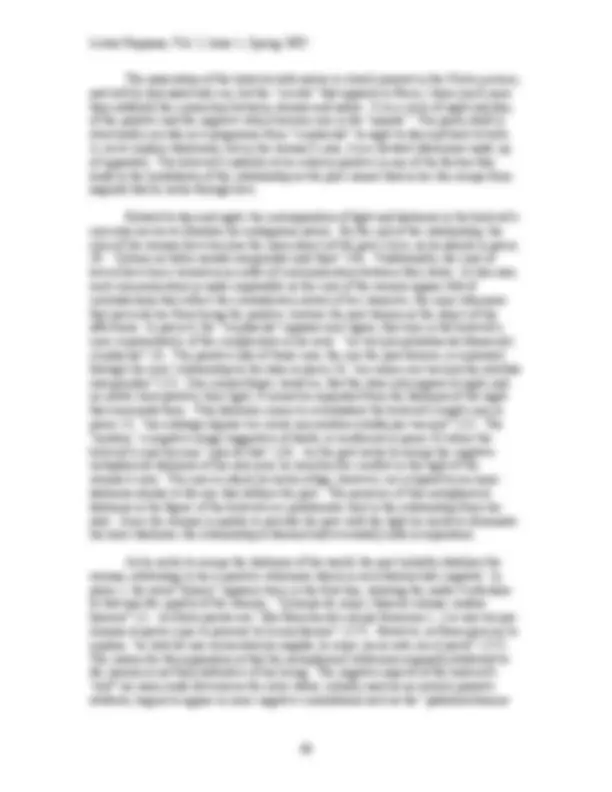
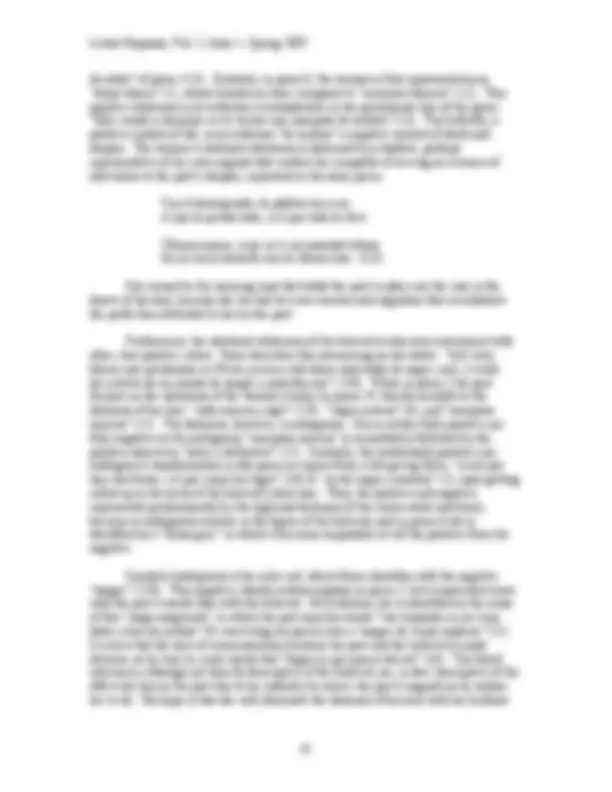
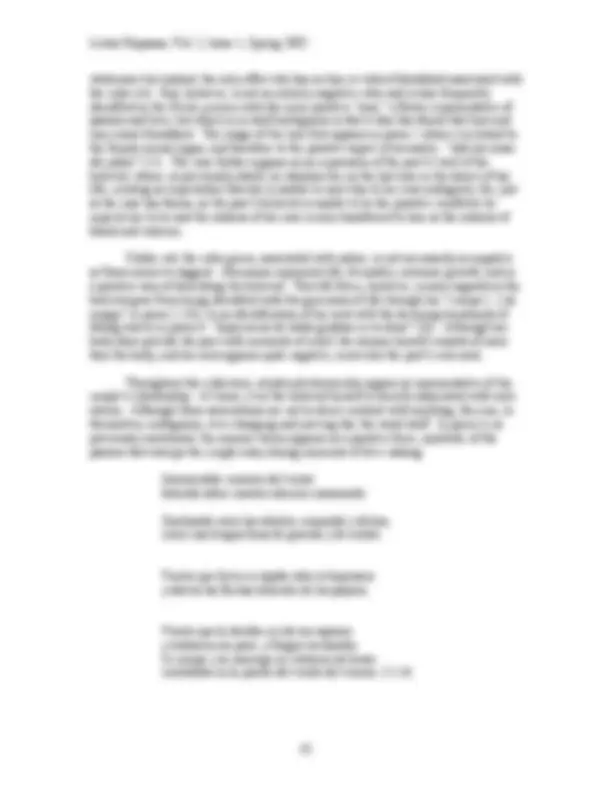
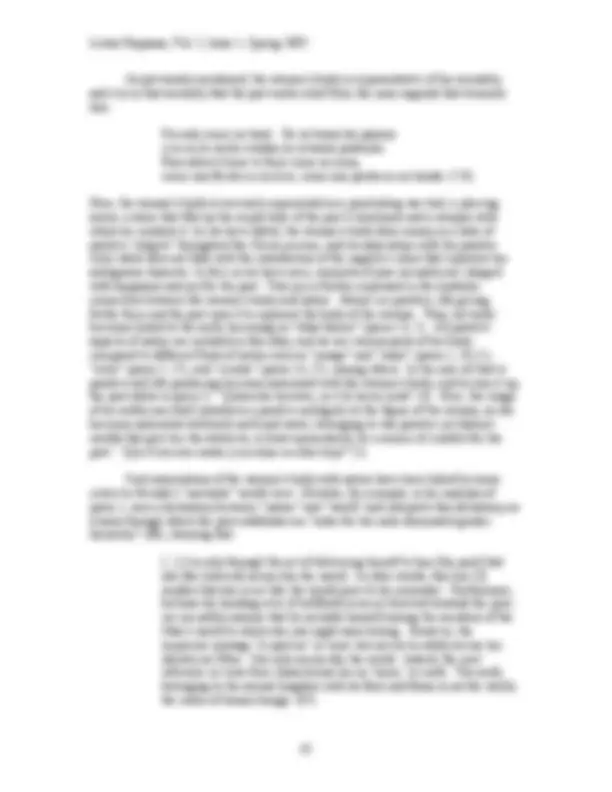

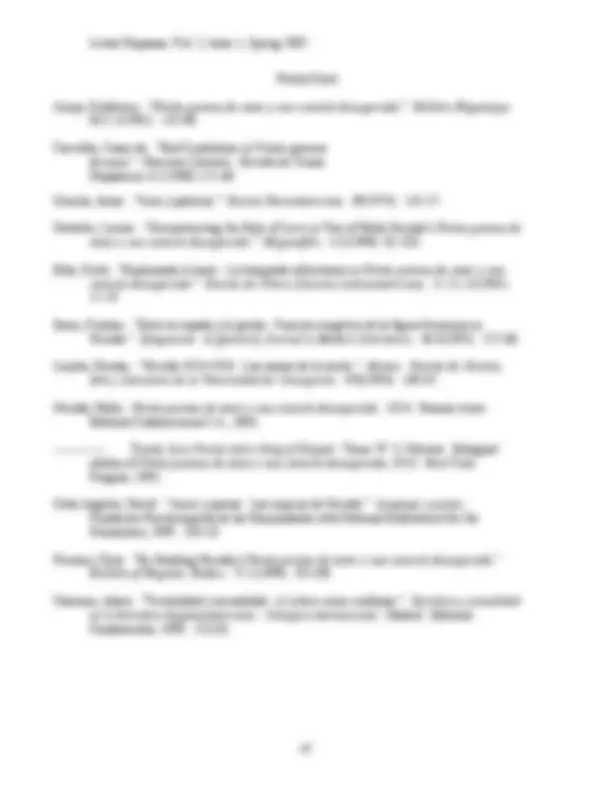


Study with the several resources on Docsity

Earn points by helping other students or get them with a premium plan


Prepare for your exams
Study with the several resources on Docsity

Earn points to download
Earn points by helping other students or get them with a premium plan
Community
Ask the community for help and clear up your study doubts
Discover the best universities in your country according to Docsity users
Free resources
Download our free guides on studying techniques, anxiety management strategies, and thesis advice from Docsity tutors
This article explores the figure of the 'amada' in Pablo Neruda's Veinte poemas de amor y una canción desesperada, focusing on the ambiguous representations of the beloved to demonstrate her independence and complexity. The poetic voice is believed to be that of a young poet suffering from anguish and despair, reflecting his social situation and poverty. The beloved is associated with day, night, and both, and her ambiguity establishes her as an intricate figure, ultimately leading to the 'Canción desesperada'.
Typology: Lecture notes
1 / 10

This page cannot be seen from the preview
Don't miss anything!







Iana Konstantinova University of Virginia
desesperada has recently become the focus of numerous critical discussions. Although many critics point out the ambiguity inherent in Neruda’s beloved, few go as far as to suggest that her ambiguity is self-contained and exists independently of the figure of the poet. Detwiler, Perriam, and Ibsen all discuss a duality present in Neruda’s collection, but all three identify this duality as being present between the woman and the poet, and not so much within the woman herself, focusing on the gender-hierarchy created by such a duality (Detwiler 87, Perriam 102, Ibsen 258). Ellis discusses the presence of antithesis, paradox, and oxymoron in the work, but attributes them to the representation of the ambiguities of love and not so much of the loved one (17). Concha sees three distinct representations of the woman in Neruda’s poetry, “la interior, la amada juvenil o la hembra objeto de goce sexual” (139), which he notes are united only by “el vínculo concreto del deseo” (144). Carvalho, on the other hand, does make direct reference to the ambiguity inherent within the woman herself, but she discusses it only in terms of bird symbolism (154). Sharman, too, points out this inherent ambiguity, but then goes on to interpret it in relation to the poetry’s textuality in an attempt to avoid criticism of the sort he calls “imágenes de la mujer” (260). It is the purpose of this article to perform precisely such criticism by examining the ambiguous representations of the beloved in Neruda’s Veinte poemas in order to show that, far from establishing a male-dominated gender hierarchy, the woman’s ambiguity establishes her as an independent and complex figure, and that her intrinsic complexity becomes the very cause of the relationship’s termination, ultimately resulting in the “Canción desesperada.”
Most critics agree that the poetic voice of the Veinte poemas is that of a young poet, reflecting Neruda himself, who is suffering a crisis that fills him with anguish and despair. Concha states that “los Veinte poemas de amor reflejan la situación social del poeta, su gris y oscura pobreza” (136). Araya describes the Veinte poemas as “el canto de este adolescente que se siente encerrado y solitario, agredido por el mundo” (150). Carvalho sees the book as “a cyclic poem with one central message – Neruda’s ultimately unsuccessful attempt to use love and woman as a barrier against existential anguish” (152). This anguish appears from the very beginning of the “poemario” as, in poem 1, the poet explains the suffering that engulfs him: “[f]ui solo como un túnel. De mí huían los pájaros / y en mí la noche entraba su invasión poderosa” (4-5). The poet feels separated from the world, and this separation creates in him a feeling of otherness, causing even the songbirds, symbolic of poetic creativity, to flee from him. The only thing that remains is the invading force of night’s darkness, representative of the depression that destroys him from within. In order to relieve his suffering, the poet looks to the “amada,” expecting to find in her a positive light to illuminate his darkness, only to realize that she, herself, suffers from a similar crisis and is unable to serve as the positive, anguish-erasing object that he originally envisions her as being.
Several critics, in an effort to better understand the woman figure in the Veinte poemas , have looked to Neruda’s explanation of the figures that inspired her, namely “Marisol” and “Marisombra.” Some, like Ellis, come to the conclusion that it does not matter who inspired the figure (13). Others, like Angleró and Araya, go in search of the women behind the clearly symbolic Marisol and Marisombra. Araya, however, decides that although they are important for purposes of inspiration, the real women do not figure in the fictional world of the book (172). Although Sharman does not discuss the women behind the beloved, he does, quite fittingly, refer to the woman of the Veinte poemas as the “(ll)amada Maris(ombra)l” (254). As Sharman’s description reveals, the “amada” is neither the “sol” nor “sombra,” but rather a combination of the two, ambiguous and full of contradictions, suffering from an “otherness” quite similar to that which causes the “angustia” of the poetic voice. The otherness of the beloved becomes apparent as one examines the contradictory images, both figurative and literal, with which the poet associates the object of his desire.
Given our discussion of Marisol and Marisombra, a good place to start the analysis of the woman’s contradictory characterization would be the place where “sol” and “sombra” meet, the “crepúsculo.” Loyola correctly identifies the beloved with the “crepúsculo,” stating that, “[e]lla reina en el crepúsculo. En cierto modo, ella es el crepúsculo [...]. Ella existe y sostiene los sueños de Pablo en esa zona de frontera entre el día residual y la noche incipiente” (170). Loyola, however, does not go on to explain what this association implies in regards to the figure of the beloved. By situating her between night and day, the poet clearly suggests a duality in the beloved’s character, a character that contains both the positive elements associated with the day and the negative ones associated with the night. This juxtaposition of night and day inherent in the “crepúsculo” can be seen in Poem 2, where the beloved is “[...] así situada / contra las viejas hélices del crepúsculo” (2-3). The poem starts out with this reference to the crepúsculo, going on to associate the beloved first with day: “pura heredera del día destruido,” (8); then with night: “[d]e la noche las grandes raíces / crecen súbitos de tu alma” (10-11); and ultimately with both: “magnética esclava / del círculo que en negro y dorado sucede” (15-16). The circle of which she is identified as a slave, is that of night and day, which Araya uses to arrive at the following conclusion about the poem’s message and symbolism and consequently about the function of the woman in the Veinte poemas :
Este círculo es el día y la noche que se siguen eternamente. Es decir, el orden natural, el ciclo natural. La mujer está sometida a la ley natural. Lo general ha sido expresado mediante la imagen del sol que es tragado por la noche y la noche que es borrada por la claridad del sol. [...] El símbolo de la mujer naturaleza está presentado en este poema mediante el sucederse de las luces y de las sombras durante el día. Sólo se ha tomado un aspecto de la naturaleza, pero su valor es universal. Por este camino el poeta ha creado una mujer que es la tierra (la naturaleza) y una naturaleza (tierra) que es vista como una mujer. En Veinte poemas ocupa mucho más espacio el desarrollo de la criatura imaginaria mujer-naturaleza. (181-2)
de adiós” of poem 4 (3). Similarly, in poem 8, the woman is first represented as an “abeja blanca” (1), whose breasts are later compared to “caracoles blancos” (12). This positive whiteness is nevertheless overshadowed, in the penultimate line of the poem: “[h]a venido a dormirse en tu vientre una mariposa de sombra” (13). The butterfly, a positive symbol of life, is nevertheless “de sombra” a negative symbol of death and despair. The woman’s idealized whiteness is darkened by a shadow, perhaps representative of her own anguish that renders her incapable of serving as a source of alleviation to the poet’s despair, expressed in the same poem:
Soy el desesperado, la palabra sin ecos, el que lo perdió todo, y el que todo lo tuvo.
Última amarra, cruje en ti mi ansiedad última En mi tierra desierta eres la última rosa. (3-6)
She cannot be the mooring rope that holds the poet in place nor the rose in the desert of his soul, because she too has her own worries and anguishes that overshadow the perfection attributed to her by the poet.
Furthermore, the idealized whiteness of the beloved is also soon intermixed with other, less positive colors. Ibsen describes this intermixing as she states: “[e]l color blanco que predomina en Veinte poemas está ahora manchado de negro, rojo, y verde: los colores de un mundo de sangre y putrefacción” (258). While in poem 1 the poet focuses on the whiteness of the woman’s body, by poem 19, this focus shifts to the darkness of her hair: “niña morena y ágil” (1,9), “negra melena” (6), and “mariposa morena” (15). The darkness, however, is ambiguous. She is neither fully positive nor fully negative as the ambiguous “mariposa morena” is immediately followed by the positive adjectives “dulce y definitiva” (15). Similarly, the traditionally positive sun undergoes a transformation in this poem as it goes from a life-giving force, “el sol que hace las frutas, / el que cuaja los trigos” (34) to “un sol negro y ansioso” (5), upon getting rolled up in the locks of the beloved’s dark hair. Thus, the positive and negative, represented predominantly by the light and darkness of the colors white and black, become an ambiguous mixture in the figure of the beloved, and in poem 6 she is identified as a “boina gris,” in which it becomes impossible to tell the positive from the negative.
Similarly ambiguous is the color red, which Ibsen identifies with the negative “sangre” (258). This negative, bloody redness appears in poem 5, but is associated more with the poet’s words than with the beloved. Nevertheless, she is identified as the cause of this “juego sangriento” in which the poet says his words “van trepando en mi viejo dolor como las yedras” (9) converting his poetry into a “sangre de viejas súplicas” (21). It is here that the lack of communication between the poet and the beloved is made obvious, as he tries to create words that “digan lo que quiero decirte” (16). The blood references, although not directly descriptive of the beloved, are, in fact, descriptive of the effect she has on the poet due to her inability to relieve the poet’s anguish as he wishes her to do. His hope is that she will illuminate the darkness of his soul with her brilliant
whiteness, but instead, the only effect she has on him is violent bloodshed associated with the color red. Red, however, is not an entirely negative color and is also frequently identified in the Veinte poemas with the more positive “rosa,” a flower representative of passion and love, but which is in itself ambiguous in that it also has thorns that hurt and may cause bloodshed. The image of the rose first appears in poem 1 where it is linked to the female sexual organ, and therefore to the positive aspect of sexuality: “[a]h las rosas del pubis” (12). The rose further appears as an expression of the poet’s view of the beloved, where, as previously stated, he idealizes her as the last rose in the desert of his life, creating an expectation that she is unable to meet due to her own ambiguity, for, just as the rose has thorns, so the poet’s beloved is unable to be the positive comforter he expects her to be and the redness of her rose is only transferred to him as the redness of blood and violence.
Unlike red, the color green, associated with nature, is not necessarily as negative as Ibsen seems to suggest. Greenness represents life, fecundity, newness, growth, and is a positive way of describing the beloved. This life-force, however, is soon negated as the beloved goes from being identified with the greenness of life through her “cuerpo [...] de musgo” in poem 1 (10), to an identification of her soul with the decaying brownness of falling leaves in poem 6: “hojas secas de otoño giraban en tu alma” (16). Although her body does provide the poet with moments of relief, the woman herself consists of more than the body, and her soul appears quite negative, much like the poet’s own soul.
Throughout the collection, winds and storms also appear as representative of the couple’s relationship. At times, even the beloved herself is directly associated with such storms. Although these associations are not in direct contrast with anything, they are, in themselves, ambiguous, ever-changing and moving like the wind itself. In poem 4, as previously mentioned, the summer storm appears as a positive force, symbolic of the passion that sweeps the couple away during moments of love making:
Innumerable corazón del viento latiendo sobre nuestro silencio enamorado.
Zumbando entre los árboles, orquestal y divino, como una lengua llena de guerras y de cantos.
Viento que lleva en rápido robo la hojarasca y desvía las flechas latientes de los pájaros.
Viento que la derriba en ola sin espuma y sustancia sin peso, y fuegos inclinados. Se rompe y se sumerge su volumen de besos combatido en la puerta del viento del verano. (5-14)
Paradoxically, the woman’s painful and deadly silence makes the poet happy because, in the midst of this silence, a single word or smile suffices for him to know that her death is not true and that she is, in fact, alive. If the woman’s presence is, as it appears to be, a source of comfort for the poet, why is it that he appears to prefer her in a state of absence? Perhaps the cause lies in the couple’s inability to communicate that Araya points out in his article:
Se trate del yo que se considera extraño y antagónico a la alegría natural de la amada o se trate de lo duro que ha sido para ésta acostumbrarse al amado, en ambos casos, el escollo está en lo sombrío del corazón del yo y lo solitario y lo salvaje de su alma. Este carácter sombrío y solitario del amador es la causa también de lo difícil que resulta su comunicación con la amada. De un modo genérico, la comunicación es de por sí problemática [...]. (165)
Here one would need to add that it is not only the “yo” whose heart is “sombrío,” but also the “amada,” who is not always defined by a natural “alegría” as Araya seems to suggest.
In fact, the beloved’s emotional state is, much like the poet’s, quite ambiguous and full of contradictions. Araya would attribute these contradictions to the difficulties that arise out of her problematic relationship with the poet, but that is not always the case. Both “tristeza” and “alegría” reside intrinsically within the beloved, who suffers from her own inner anguish and is therefore unable to fully comfort the poet’s suffering. In poem 2, she is initially described as “pálida doliente” (2), an image which is intensified at the poem’s climax: “y llena es de tristeza” (18). Even when she is not defined by sadness, the state can come over the beloved suddenly, as it does in poem 12: “[y] entristeces de pronto, como un viaje” (12). In moments such as this, the poet attempts to cheer up his beloved as he does in poem 13 with “historias para contarte [...] / muñeca triste y dulce para que no estuvieras triste” (5-6). Even in times of “tristeza,” however, the “amada” is still “dulce,” ambiguously escaping all definition. The only aspect of her being that remains in a state of happiness throughout the Veinte poemas is her physical body, the “cuerpo alegre” (poem 19, 3) that is the primary object of the poet’s desire at the beginning of the “poemario” and throughout the majority of the poems. Although, as the relationship progresses, the woman’s eyes, representative of her soul, and her voice, representative of the communication between the two, come into competition with her body, the body continues to hold its privileged position until the last poem. Once the “amada” is gone, the poet realizes that he loved her entire being, lamenting the possibility of having lost her to another: “[d]e otro. Será de otro. Como antes de mis besos. / Su voz, su cuerpo claro. Sus ojos infinitos” (17). Before that, in poem 19, the poet states: “amo tu cuerpo alegre, tu voz suelta y delgada” (14), clearly placing the body before the voice, and never contradicting himself in regards to the sexual attraction represented by the body as we have seen him do in regards to the more personal attraction represented by the woman’s voice.
As previously mentioned, the woman’s body is representative of her sexuality, and it is in that sexuality that the poet seeks relief from the inner anguish that torments him:
Fui solo como un túnel. De mí huían los pájaros y en mí la noche entraba su invasión poderosa. Para sobrevivirme te forjé como un arma, como una flecha en mi arco, como una piedra en mi honda. (5-8).
Here, the woman’s body is inversely represented as a penetrating war tool, a piercing arrow, a stone that fills up the empty hole of the poet’s loneliness and a weapon with which he combats it. As we have stated, the woman’s body does remain in a state of positive “alegría” throughout the Veinte poemas , and its association with the positive color white does not fade with the introduction of the negative colors that represent her ambiguous character In fact, as we have seen, moments of pure sexuality are charged with happiness and joy for the poet. This joy is further expressed in the symbolic connection between the woman’s body and nature. Nature is a positive, life-giving, fertile force and the poet uses it to represent the body of the woman. Thus, her body becomes linked to the earth, becoming an “atlas blanco” (poem 13, 2). All positive aspects of nature are included in this atlas, and we see various parts of her body compared to different fruits of nature such as “musgo” and “rosas” (poem 1, 10,11), “uvas” (poem 5, 27), and “ciruela” (poem 14, 25), among others. In the end, all that is positive and life-producing becomes associated with the woman’s body, and to sum it up, the poet states in poem 3: “[c]aracola terrestre, en ti la tierra canta” (4). Here, the image of an earthly sea shell introduces a positive ambiguity to the figure of the woman, as she becomes associated with both earth and water, belonging to two positive yet distinct worlds that give her the ability to, at least momentarily, be a source of comfort for the poet: “[e]n ti los ríos cantan y mi alma en ellos huye” (5).
Such associations of the woman’s body with nature have been linked by some critics to Neruda’s “machista” world view. Detwiler, for example, in her analysis of poem 1, sees a dichotomy between “nature” and “world” and interprets this dichotomy as a basis through which the poet establishes an “order for the male-dominated gender hierarchy” (88), claiming that:
[...] it is only through the act of delivering herself to him [the poet] that she [the beloved] seems like the world. In other words, this line [2] implies that she is not like the world prior to her surrender. Furthermore, because her handing over of self/body is an act directed towards the poet, we can safely assume that he includes himself among the members of the Man’s world to which she just might soon belong. However, the imprecise message ‘te pareces’ in verse two serves to subtly secure her identity as Other. She only seems like the world. Indeed, the next reference in verse four characterizes her as ‘tierra,’ or earth. The earth, belonging to the animal kingdom with its flora and fauna is not the world, the realm of human beings. (87)
Works Cited
Araya, Guillermo. “ Veinte poemas de amor y una canción desesperada .” Bulletin Hispanique. 84:1-2(1982). 145-88.
Carvalho, Susan de. "Bird Symbolism in Veinte poemas de amor." Discurso Literario: Revista de Temas Hispánicos. 6.1(1988):151-60.
Concha, Jaime. “Sexo y pobreza.” Revista Iberoamericana. 39(1973). 135-57.
Detwiler, Louise. “Deconstructing the Role of Love in Two of Pablo Neruda’s Veinte poemas de amor y una canción desesperada .” Hispanófila. 122(1998). 85-103.
Ellis, Keith. “Explorando el amor: La búsqueda infructuosa en Veinte poemas de amor y una canción desesperada. ” Revista de Crítica Literaria Latinoamericana. 11:21-22(1985). 11-19.
Ibsen, Kristine. “Entre la espada y la piedra: Función exegética de la figura femenina en Neruda.” Symposium: A Quarterly Journal in Modern Literatures. 46:4(1993). 257-68.
Loyola, Hernán. “Neruda 1924-1926: Las manos de la noche.” Atenea: Revista de Ciencia, Arte y Literatura de la Universidad de Concepción. 470(1994). 169-87.
Neruda, Pablo. Veinte poemas de amor y una canción desesperada. 1924. Buenos Aires: Editorial Sudamericana S.A., 2003.
------------- Twenty Love Poems and a Song of Despair. Trans. W. S. Merwin. Bilingual edition of Veinte poemas de amor y una canción desesperada , 1924. New York: Penguin, 1993.
Ortiz Angleró, David. “Amor y poesía: Las mujeres de Neruda.” Lenguaje y poesía. Fundación Puertorriqueña de las Humanidades with National Endowment for the Humanities, 1999. 103-18.
Perriam, Chris. “Re-Reading Neruda’s Veinte poemas de amor y una canción desesperada. ” Bulletin of Hispanic Studies. 75:1(1998). 93-108.
Sharman, Adam. “Textualidad y sexualidad: el crítico como confessor.” Escritura y sexualidad en la literatura hispanoamericana: Coloquio internacional. Madrid: Editorial Fundamentos, 1990. 253-83.